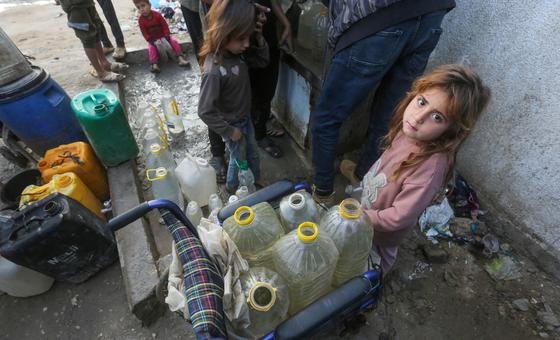Dr. “In the coming weeks, the goal is to deliver 500 to 600 truckloads of aid per day,” said Rick Peppercorn, WHO representative in Israel’s Occupied Palestinian Territory (OPT).
The number of trucks loaded with aid represents a “huge increase” compared to 40 to 50 trucks arriving daily in Gaza in recent months.
A huge challenge
Dr. WHO physician. Rick Peppercorn, speaking from Jerusalem, called the cease-fire announcement a “sign of hope” but warned that the challenge was huge and long-term due to severe shortages of food, fuel and medical supplies.
Senior humanitarian aid worker Dr Peppercorn said aid deliveries were planned to begin as soon as the ceasefire took effect on Sunday.
“We have ordered ready-made temporary clinics and hospitals that we can integrate with existing facilities.
This will help to slightly increase the required bed capacity and meet the immediate health and healthcare needs.
Humanitarian workers have repeatedly warned that the crisis for Gaza’s civilians has reached catastrophic levels.
According to Gaza health officials, more than 46,000 people have been killed and more than 110,000 injured since the war began in October 2023. Many of these have suffered life-changing injuries.
Dr. Rick Peppercorn said the disease is spreading and the threat of famine remains, which needs to be addressed, especially as more than 12,000 patients still need to be evacuated to better medical facilities for specialized care. One-third of this number are children.
Slow progression of withdrawal
But evacuation of patients is very slow. According to the WHO, only 29 of the 1,200 requests submitted to Israeli authorities between November and December 2024 were approved, or just 2.4 percent.
WHO and other organizations have emphasized the urgent need to provide fuel, generators and spare parts to hospitals along with food, water and medical supplies.
Gaza’s health care system has collapsed. Currently, only half of its 36 hospitals are operational.
According to the United Nations Health Organization, critical health infrastructure is being targeted, pointing to 664 attacks on health services since October (2023).
The attack resulted in the deaths of civilians and medical personnel, as well as severe damage to critical health facilities.
Despite the dire situation, WHO aims to implement an ambitious 60-day emergency health action plan once the ceasefire takes effect.
This includes scaling up existing health efforts, setting up temporary medical clinics and restoring essential health services.
Efforts will also focus on tackling malnutrition, strengthening disease surveillance and providing medical care to areas that have been difficult to reach so far.
Health needs $10 billion
According to the WHO, more than $10 billion is needed to restore Gaza’s shattered health care system.
The agency said substantial international support would also be needed to avoid future loss of life and prevent the complete collapse of the region’s health infrastructure.
In addition to meeting immediate health needs, there is also an urgent need for extensive humanitarian assistance.
Food, clean water and shelter are basic priorities, other critical medicines and medical equipment are in short supply.
For now, international organizations continue to operate under difficult and dangerous conditions. Hopefully, once the ceasefire comes into effect, the people trapped in the occupation and siege of the Gaza Strip will be able to live.

